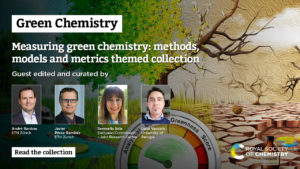Green Chemistry and Polymer Chemistry are delighted to announce a call for papers to the Make polymers sustainable, why and how? cross journal Themed Collection, Guest Edited by Maiyong Zhu (Jiangsu University), Gerard Lligadas (Universitat Rovira i Virgili), Fiona L. Hatton (Loughborough University), Garret Miyake (Colorado State University), and Antoine Buchard (University of York).
About this Themed Collection
It is estimated that more than 300 million tons of synthetic polymeric materials are being produced every year and most are made from petroleum-based feedstocks. As the global consumption of polymers increases each year, this puts an unsustainable demand on our finite and non-renewable fossil fuel resources. In addition, the ever-growing quantity of polymers becoming waste at the end of their life presents serious environmental problems due to their persistence and potential ecotoxicity. This themed collection will showcase cutting-edge research and advancements in developing more sustainable methods to tackle these global challenges.
Great achievements have been made so far, including alternative renewable monomers derived from biomass, synthetic biodegradable polymers, and synthetic processes, such as those using molten salts, deep eutectic solvents, ionic liquids, and high-performance catalysts have shown great energy efficiency during the production of polymers. Additionally, the emergence and wide interest for circular economy principles have promoted research into the recycling (including chemical) of polymers, adding value to post-consumed polymers. Furthermore, artificial intelligence and machine learning have been offering new powerful tools for scientists and engineers to guide the design and synthesis of novel polymers, as well as to predict their properties, in order to efficiently meet the requirements for a sustainable development.
Preferred topics include but are not limited to:
- Green synthetic approaches to polymers
- Polymers derived from renewable monomers/feedstock
- Polymers from agricultural waste
- Bio-based vitrimers, thermosets and resins
- Life cycle analysis of polymers
- Polymers recycling to monomer or materials with equivalent function
- Upcycling end-of-life polymers
- Machine learning for sustainable polymers
- Ecotoxicity and toxicity of bio-derived polymers
Open for Submissions until 31st May 2025
This call for papers is open for the following article types:
- Communications
- Full papers
- Reviews
How to Submit
If you would like to contribute to this themed collection, you can submit your article directly to the online submission system for Green Chemistry or Polymer Chemistry. Please answer the themed collection question in the submission form when uploading your files to say that this is a contribution to the Make polymers sustainable, why and how? themed collection.
Please note that while we welcome submissions to Green Chemistry and Polymer Chemistry, we are unable to guarantee peer review or eventual acceptance in your chosen journal. If a submission is not found to be suitable for the chosen journal, we will endeavour to find the most suitable home within our portfolio of journals.













